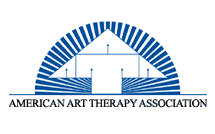 Frequently Asked Questions Download PDF Version
Visual expression has been used for healing throughout history, but art therapy did not emerge as a distinct profession until the 1940s. In the early 20th century, psychiatrists became interested in the artwork created by their patients with mental illness. At around the same time, educators were discovering that children's art expressions reflected developmental, emotional, and cognitive growth. By mid-century, hospitals, clinics, and rehabilitation centers increasingly began to include art therapy programs along with traditional "talk therapies," underscoring the recognition that the creative process of art making enhanced recovery, health, and wellness. As a result, the profession of art therapy grew into an effective and important method of communication, assessment, and treatment with children and adults in a variety of settings. Currently, the field of art therapy has gained attention in health-care facilities throughout the United States and within psychiatry, psychology, counseling, education, and the arts. For more detailed information on the history of art therapy, please see AATA's publication list for A History of Art Therapy in the United States.
Art therapists work in a wide variety of settings, including, but not limited to, the following:
- Hospitals and clinics, both medical and psychiatric
- Out-patient mental health agencies and day treatment facilities
- Residential treatment centers
- Halfway houses
- Domestic violence and homeless shelters
- Community agencies and non-profit settings
- Sheltered workshops
- Schools, colleges, and universities
- Correctional facilities
- Elder care facilities
- Art studios
- Private practice
An art therapist may work as part of a team that includes physicians, psychologists, nurses, mental health counselors, marriage and family therapists, rehabilitation counselors, social workers, and teachers. Together, they determine and implement a client's therapeutic goals and objectives. Other art therapists work independently and maintain private practices with children, adolescents, adults, groups, and/or families.
Personal Qualifications: An art therapist must have sensitivity, empathy, emotional stability, patience, interpersonal skills, insight into human behavior, and an understanding of art media. An art therapist must also be an attentive listener and a keen observer. Flexibility and a sense of humor are important in adapting to client needs and work setting.
Educational Requirements: One must complete the required core curriculum as outlined in the AATA Education Standards to qualify as a professional art therapist. Entry into the profession of art therapy is at the master's level. Graduate level art therapy programs include:
- Master's degree in art therapy
- Master's degree with an emphasis in art therapy
- Twenty-four (24) semester units in art therapy coursework with a Master's degree in a related field.
Contact the AATA National Office for more information concerning current educational requirements and programs.
Registration and Board Certification Requirements: The ATR and ATR-BC are the recognized standards for the field of art therapy, and are conferred by the Art Therapy Credentials Board (ATCB). In order to qualify as a registered art therapist (ATR), in addition to the educational requirements, an individual must complete a minimum of 1,000 direct client contact hours after graduation. One hour of supervision is required for every ten hours of client contact.
Art therapy is an expanding field and employment continues to increase as art therapy becomes recognized by professionals, work settings, and clients. Graduates of art therapy programs are successful at finding employment in both full and part-time positions.
Earning for art therapists vary geographically depending on the type of practice and job responsibilities. Entry level income is approximately $32,000, median income of $45,000, and top earning potential for salaried administrators ranges between $50,000 and $100,000. Art therapists with doctoral degrees, state licensure, or who qualify in their state to conduct private practice, have an earning potential of $75 to $150 per hour in private practice. State requirements for private practice vary across the country, so please check with the licensing board in the state in which you plan to practice for rules and regulations.
There are a number of resources available to an art therapist seeking employment, including college placement offices, contacts formed during internship placements, and professional organizations newsletters and journals. Memberships in the AATA and AATA Affiliate Chapters, federal and state employers, and job information banks (such as the AATA Members Only job postings) are also resources for employment opportunities.
The American Art Therapy Association, Inc. (AATA) promotes and regulates the educational, professional, and ethical standards for art therapists and is the official member organization for professionals and students in the field of art therapy. The Art Therapy Credentials Board (ATCB), a separate organization, grants registration (ATR) after reviewing documentation of completion of graduate education and postgraduate supervised experience. The Registered Art Therapist (ATR) who successfully passes the written examination administered by the ATCB is qualified as Board Certified (ATR-BC), a credential requiring maintenance through continuing education.
|





